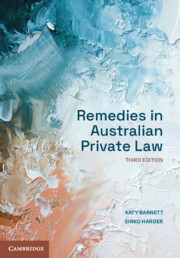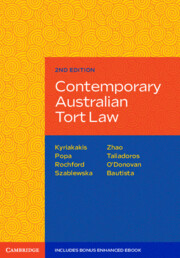Refine search
Actions for selected content:
151 results
19 - Unfair Dismissal
- from Part V - Termination of Employment
-
- Book:
- Labour Law
- Published online:
- 02 October 2025
- Print publication:
- 31 October 2025, pp 861-917
-
- Chapter
- Export citation
8 - Working Time
- from Part III - Statutory Regulation of the Employment Relationship
-
- Book:
- Labour Law
- Published online:
- 02 October 2025
- Print publication:
- 31 October 2025, pp 284-328
-
- Chapter
- Export citation
Chapter 5 - The internal rules of a company
-
- Book:
- Contemporary Australian Corporate Law
- Published online:
- 11 September 2025
- Print publication:
- 25 September 2025, pp 141-168
-
- Chapter
- Export citation
Chapter 14 - Members’ rights and remedies
-
- Book:
- Contemporary Australian Corporate Law
- Published online:
- 11 September 2025
- Print publication:
- 25 September 2025, pp 446-492
-
- Chapter
- Export citation
4 - Morality Clauses in Tennis Agreements
- from Part 1 - Contractual
-
-
- Book:
- Professional Tennis and Transnational Law
- Published online:
- 07 August 2025
- Print publication:
- 21 August 2025, pp 69-87
-
- Chapter
-
- You have access
- Open access
- HTML
- Export citation
14 - Intergenerational Equity
- from Part III - Regime Interaction and Interpretation
-
-
- Book:
- The Cambridge Handbook on Climate Litigation
- Published online:
- 03 June 2025
- Print publication:
- 31 July 2025, pp 344-368
-
- Chapter
-
- You have access
- Open access
- HTML
- Export citation
18 - Remedies
- from Part IV - Liability and Evidence
-
-
- Book:
- The Cambridge Handbook on Climate Litigation
- Published online:
- 03 June 2025
- Print publication:
- 31 July 2025, pp 445-471
-
- Chapter
-
- You have access
- Open access
- HTML
- Export citation
Chapter 8 - State responsibility
-
- Book:
- International Law
- Published online:
- 26 July 2025
- Print publication:
- 31 July 2025, pp 413-476
-
- Chapter
- Export citation
4 - Co-ownership and Neighbour Relations
-
- Book:
- Property Law in China
- Published online:
- 09 July 2025
- Print publication:
- 24 July 2025, pp 98-125
-
- Chapter
- Export citation
Transnational Legal Clinic Collaboration: A Force in Global Climate Litigation
-
- Journal:
- Transnational Environmental Law / Volume 14 / Issue 2 / July 2025
- Published online by Cambridge University Press:
- 26 May 2025, pp. 266-284
-
- Article
-
- You have access
- Open access
- HTML
- Export citation
2 - Diplomatic Protection
- from Part I - The Individual in the Law of the International Court of Justice
-
- Book:
- The Individual in the Law and Practice of the International Court of Justice
- Published online:
- 25 March 2025
- Print publication:
- 08 May 2025, pp 42-69
-
- Chapter
- Export citation
The Metrics of the DMA’s Success
-
- Journal:
- European Journal of Risk Regulation , First View
- Published online by Cambridge University Press:
- 12 February 2025, pp. 1-21
-
- Article
-
- You have access
- Open access
- HTML
- Export citation
6 - The Role of National Courts in Redressing Fundamental Rights Violations by the EU
- from Part II - Remedies beyond the CJEU
-
-
- Book:
- Redressing Fundamental Rights Violations by the EU
- Published online:
- 21 December 2024
- Print publication:
- 12 December 2024, pp 155-176
-
- Chapter
-
- You have access
- Open access
- HTML
- Export citation

Remedies in Australian Private Law
-
- Published online:
- 25 October 2024
- Print publication:
- 12 November 2024
-
- Textbook
- Export citation
Chapter Eight - The Award
-
- Book:
- The Principles and Practice of International Commercial Arbitration
- Published online:
- 11 January 2024
- Print publication:
- 01 February 2024, pp 199-213
-
- Chapter
- Export citation
12 - The Role of Customary International Law in International Investment Law Remedies
- from Part III - Interpreting Customary International Rules
-
-
- Book:
- Custom and its Interpretation in International Investment Law
- Published online:
- 04 January 2024
- Print publication:
- 18 January 2024, pp 284-306
-
- Chapter
-
- You have access
- Open access
- HTML
- Export citation
8 - Defences to and remedies for trespass
-
- Book:
- Contemporary Australian Tort Law
- Published online:
- 05 January 2024
- Print publication:
- 16 January 2024, pp 366-414
-
- Chapter
- Export citation
12 - Remedies
-
- Book:
- Contemporary Australian Tort Law
- Published online:
- 05 January 2024
- Print publication:
- 16 January 2024, pp 579-662
-
- Chapter
- Export citation
6 - Trespass to the person
-
- Book:
- Contemporary Australian Tort Law
- Published online:
- 05 January 2024
- Print publication:
- 16 January 2024, pp 263-310
-
- Chapter
- Export citation

Contemporary Australian Tort Law
-
- Published online:
- 05 January 2024
- Print publication:
- 16 January 2024
-
- Textbook
- Export citation
